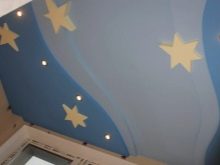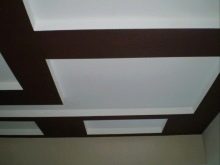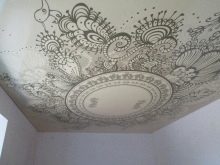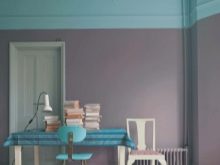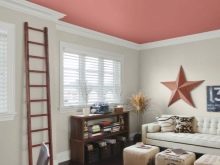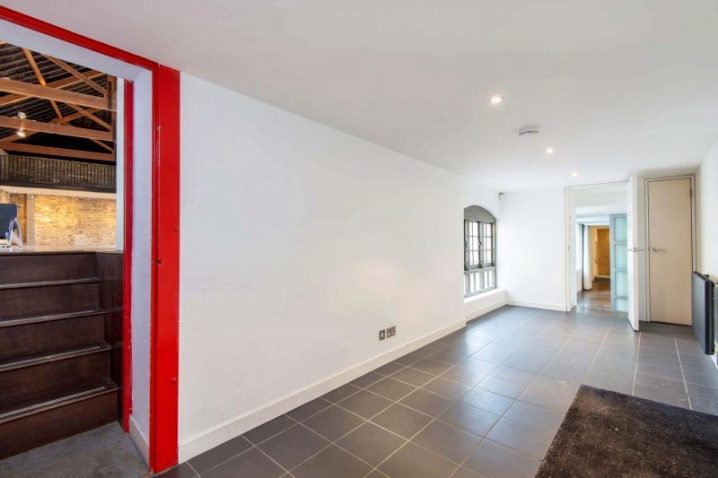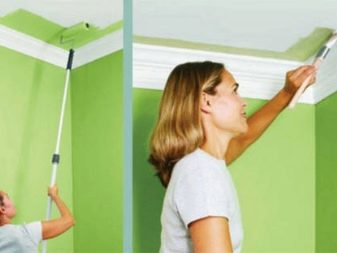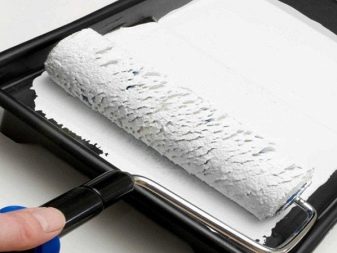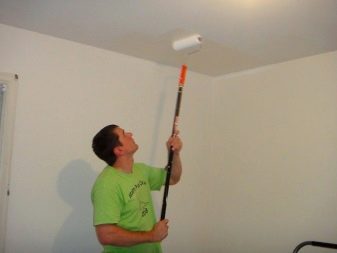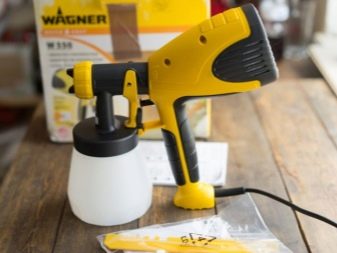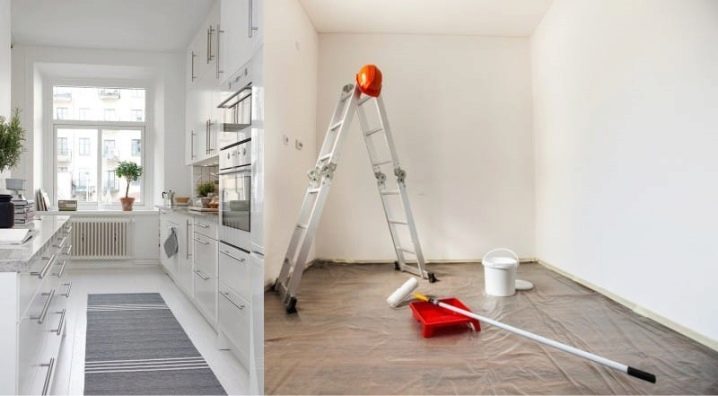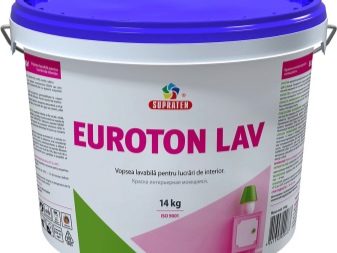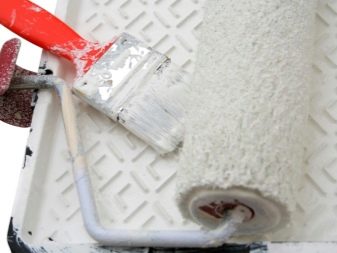Painting the ceiling: painting on the old paint
It so happens that when painting the ceiling, the old paintwork is removed, but sometimes this stage is missed. If you do everything right, then in this situation the result will be surprisingly good. After reading the article, you will learn how to paint on the old paint.
Process features
Paint the ceiling is not as difficult as it seems at first glance. As a rule, before this process, workers clean off the old finish layer. The fact is that a thick layer of old paint can shine through and spoil the appearance of the surface. If cracks appeared on the ceiling, then the case is completely hopeless - no matter how you paint them, they will still be visible. If the repair has not been done for a long time, then under a layer of old paint you can detect mold at all, which will negate all your attempts to update the surface.
If there are no such serious problems, then you can safely apply a new layer of water-based emulsion, acrylic, to the old paint. Carefully inspect your ceiling. If its appearance suits you, but the pieces of paint do not fall off, you can leave everything as it is.
Professionals advise to pay attention to the following: if you used to paint the ceiling with water-based paint, then you are lucky. She better whitewash. Even if the paint of this type begins to peel off and fall off in pieces, then it can be removed not completely. You can safely restrict the surface cleaning, removing flaking pieces and cleaning the area around them. After this short work, you can safely apply a new layer of paint.
Paint selection
If you decide to cover the ceiling with paint on top of the old layer of material, then you will be faced with the question of choosing a suitable option. For such works different paints are used. Each type has its own advantages and a number of disadvantages.
Acrylic
Perhaps this type of paint is most popular. It is good because it is characterized by increased resistance to all kinds of pollution and dries quickly.So you can safely use this material, for example, in the kitchen, where work with food does not always go smoothly.
This paint can also withstand high humidity. If there is any contamination on the painted surface, it can be safely removed with a damp cloth or a napkin, without fear that the paint will crack.
Acrylic paint can be easily applied to a variety of surfaces. It fits well on metal, and wood, and plastic, and even on the already plastered bases.
Painting with acrylics is also good because it perfectly hides minor surface imperfections. Textured paint can disguise small cracks or places where the pieces of the coating have already fallen off.
It is pleasantly pleased that such a coating dries quickly and permanently retains its color. Even if you paint the ceiling in a room where the sun's rays will constantly fall on it, the paint will fade and burn out immediately. However, there is one caveat: choosing this type of paint, remember that the color of the coating applied to the ceiling will differ slightly from the one you see on the package, because the material darkens immediately.This cannot be called such a big disadvantage, because there are so many flowers, and you can always find exactly the shade that will suit you in the end.
With all these positive points worth noting that the paint is not so expensive. You can buy a kilogram of paint for about a thousand rubles. Yes, and it will be spent quite slowly - to paint the ceiling in a room of medium size, you will need less packaging material. About 100 g of paint is consumed per square meter.
Latex
There are several other types of paints that are suitable for the ceiling. One of the most expensive options is latex. This paint is ideal for painting the ceiling on top of the old layer. The fact is that it perfectly masks defects, microcracks on any surfaces. The ceiling painted with this material you can calmly wash or wipe with a brush.
Silikantnaya
Cracks (up to two millimeters) are able to mask and silicate paint. However, it is more expensive than most analogs.
In addition, it is important to remember also that silicate paints are generally not used in residential areas.
This is a coating that is used for profile wall decoration. and ceilings in industrial premises - for example, in warehouses. At the heart of such paint - liquid glass. Best of all, this coating rests on a concrete or stone surface.
Water emulsion
Water dispersion paint also often painted ceilings. However, it should be used in dry rooms - for example, in living rooms or bedrooms. This type of coating does not tolerate high humidity and quickly becomes covered with cracks, dark spots (in the bathroom or even in the kitchen). The cost of water-dispersion paint is low, which just makes it popular. In addition, it can be both matte and glossy, which is convenient for those who design their premises in a certain style and do not want to disturb the harmony in the room.
You can choose any of these basic types of paint for repainting the ceiling. It can be dense and structural, oil, very light - it all depends on what your ceiling, what are your financial capabilities.
Instruments
The next stage is the selection of suitable tools. Most often for painting the ceiling using either a roller or a wide brush.
Tassels
Brushes of different sizes can be used for dyeing the base, and for the joints, elements of decoration. When painting the main part of the ceiling, they are not very effective.
If you decide to paint such a large surface with brushes, then choose the widest. Places joints with walls, stucco and other decorative details just more convenient to paint with brushes.
Roller
It is much more convenient to paint the ceiling with a roller. For painting the ceiling using foam tools. The second most popular option is a roller with a fabric base. The length of this tool for painting the ceiling can vary from five to thirty centimeters.
Spray gun
The most effective use of the spray gun. However, this option is not preferred by all. The fact is that the airbrush is not only more expensive than all other devices, but also more difficult to use. If you are not a professional, then you will need to adapt to the spray gun.
How to dilute and calculate the amount?
Having decided on the type of paint and tools, you can proceed to the preparatory work. First you need to dilute the required amount of material.
Paint consumption depends on how big your room is., the ceiling area is very important. As a rule, all the necessary information that will help you carry out the calculation of the paint is on the package. Check out this information.
Choosing water-based paint, you will see on the packaging that it should not be diluted. If the product you have bought has already thickened, then you can slightly dilute it with water. Otherwise, just mix the paint, roll it with a roller on the pallet and start painting.
The preparation of other ceiling paints is no different. In the acrylic mixture, too, will need to add some water. It is best to use the product immediately after you stir it. Do not let it freeze.
Application details
Painting the ceiling without first removing the old layer of paint is slightly different from the usual repair work. You will save some time, because you do not have to completely remove the old layer and putty or primer the ceiling again. It will be enough to work out the zones with cracks and remove falling off pieces of paintwork material.If the paint peels off, it will need to be fixed, otherwise the surface of the ceiling will appear uneven and sloppy.
When you cope with the most noticeable flaws, you will need to move on to the main work. Divorced paint should be poured into the tray - it should not be too much so that the remnants are not dried up or thrown away.
Coloring the ceiling begins with the most inaccessible places. Walk on them with a narrow brush so that there are no gaps left. After that you can paint the entire surface. Work best roller. So you can quickly paint the ceiling over the old layer and paint over the cracks, stains.
It is recommended to paint the ceiling in several stages. The first layer can be applied not very carefully, but it will be necessary to work very well on the second one. It is worth starting work with the second layer only after the first completely dries.
Paint the ceiling with your own hands is not very difficult, even if you do it for the first time. Follow the simple guidelines, be careful - and you will succeed.
Design Ideas
The ceiling is a very important part of the interior.How the room will be perceived largely depends on how you design it.
If you like minimalism or Finnish style, then the ceiling should not be made bright and filled with a variety of patterns. Monotonous finish is best. Choose a color that you like and work only with it. It is recommended to give preference to light tones, as they help to visually make the room taller.
Look more interesting ceilings, decorated with all sorts of drawings. It can be abstract patterns created by thin brushes, or full-fledged drawings. However, working on their creation is more difficult.
To paint the ceiling on top of an old layer of paintwork is not such a difficult job. You can easily and quickly change the look of the room with your own hands and create the design of your dreams.
How to paint a ceiling, look in the following video.

